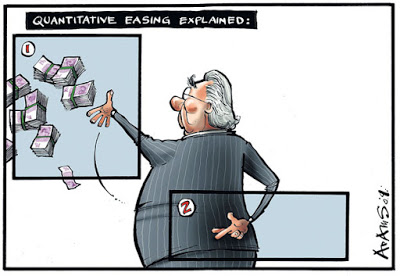Complex technical stuff indeed Pascal Blanqué and Amin Rajan complain about unconventional monetary policy, low or negative rates and Quantitative Easing, which they mostly blame on Greenspan and the excessive reliance on the lender of last resort (LOLR) function of the central banks (even though this precedes Greenspan). They say: The US example shows all too clearly that the longer such unconventional policy remains in place, the harder it is to exit. Most likely, ultra-low rates will remain a fact of life for the foreseeable future, with no return to a scenario in which asset prices mostly reflect their intrinsic worth... Negative interest rates are a dangerous comfort blanket. They show that the proverbial punch bowl will continue to be replenished while the party is on. Investing is now mostly about second guessing the central banks’ next move, which even central banks themselves are not sure about. I have a more benign view of unconventional monetary policy. It is there to support expansionary fiscal policy. But that has been like waiting for Godot. What the US example really shows is that, in the absence of significant fiscal expansion, monetary policy is not sufficient to get the economy out of the hole. You need to use the low rates, which allow government to borrow on the cheap, and boost public investment. Infrastructure spending used to be a no brainer.
Topics:
Matias Vernengo considers the following as important: austerity, LOLR, QE
This could be interesting, too:
Nick Falvo writes Report finds insufficient daytime options for people experiencing homelessness
Frances Coppola writes When populism fails
Frances Coppola writes How to use People’s QE to fight climate change
Frances Coppola writes David and Goliath
I have a more benign view of unconventional monetary policy. It is there to support expansionary fiscal policy. But that has been like waiting for Godot. What the US example really shows is that, in the absence of significant fiscal expansion, monetary policy is not sufficient to get the economy out of the hole. You need to use the low rates, which allow government to borrow on the cheap, and boost public investment. Infrastructure spending used to be a no brainer.The US example shows all too clearly that the longer such unconventional policy remains in place, the harder it is to exit. Most likely, ultra-low rates will remain a fact of life for the foreseeable future, with no return to a scenario in which asset prices mostly reflect their intrinsic worth... Negative interest rates are a dangerous comfort blanket. They show that the proverbial punch bowl will continue to be replenished while the party is on. Investing is now mostly about second guessing the central banks’ next move, which even central banks themselves are not sure about.
So the problem is not the central bank as a sugar daddy, but the stagnation policy which results from a consensus that budgets have to be balanced, and spending reduced. The legacy of almost four decades of conservative economics, which, by the way, has been accepted by too many left of center parties.

